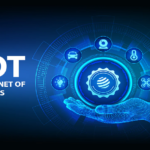 IoT devices are transforming digital banking, from wearables and smartphones to smart ATMs and branch sensors. They enable banks to offer hyper-personalised services, seamless omnichannel experiences, and enhanced customer security.
IoT devices are transforming digital banking, from wearables and smartphones to smart ATMs and branch sensors. They enable banks to offer hyper-personalised services, seamless omnichannel experiences, and enhanced customer security.
This guide outlines how IoT reshapes digital banking, with practical insights for retail customers and SMEs. It also highlights the role of reliable broadband for SMEs in maximising IoT’s potential in banking operations.
Personalised Financial Advice and Offers
IoT devices like smartphones and wearables continuously collect data on customer behaviour, preferences, and context. Banks use this real-time data to deliver instant, personalised financial insights and recommendations, such as:
- Savings tips based on current account activity
- Targeted promotions aligned with recent purchases
- Customised loan options triggered by life events (travel, large purchases, etc.)
For example, some leading banks analyse mobile app usage patterns and wearable data to push personalised offers, boosting engagement and loyalty.
Seamless, Omnichannel Experiences
IoT devices form a bridge between digital apps, physical branches, and ATMs. Customers can start a transaction on one channel and finish on another without losing context.
For instance:
- Smart sensors and beacons guide customers inside branches, reducing wait times
- Real-time foot traffic data helps optimise staffing and appointment scheduling
- Integration with smart home assistants enables voice-based banking from anywhere
This results in a unified, frictionless experience across all customer touchpoints.
Proactive Customer Support
IoT devices enable banks to anticipate issues and provide proactive support:
- Connected ATMs detect cash shortages or technical problems, triggering maintenance before customers are impacted
- Real-time monitoring sends instant low-balance or suspicious activity alerts to customers
- Chatbots use IoT context to provide relevant, personalised support and guidance
By resolving problems before they escalate, banks dramatically improve customer satisfaction and trust. For instance, if a customer’s smartwatch detects that she is in a foreign country, a chatbot could respond proactively. It might provide information on using her card abroad, exchange rates, and travel notifications.
Enhanced Security and Fraud Prevention
IoT devices are making banking transactions faster and more secure than ever:
- Biometric authentication (fingerprint, facial recognition) through smart devices enables quick, password-free verification
- Real-time location tracking flags suspicious transactions from unexpected places
- Multi-factor authentication, combining phone notifications and biometric validation, prevents unauthorised access
With IoT-powered, multi-layered security, customers can bank with confidence.
Connected Payments and Commerce
IoT devices are enabling new, convenient forms of payments:
- Wearables with tokenised card information allow tap-and-go, hands-free payments
- Smart appliances with integrated payment capabilities simplify purchases
- Connected cars with digital wallets make drive-through payments seamless
By extending the boundaries of payments, IoT is creating a world of frictionless commerce for bank customers.
Innovative Insurance Models
Some insurers are using IoT devices to create usage-based, personalised policies:
- Analysing wearable data (activity, sleep) to offer dynamic health insurance premiums
- Tracking driving behaviour through vehicle sensors to customise auto insurance
- Providing discounts for homes with smart safety devices (smoke alarms, leak detectors)
This IoT-driven shift towards transparent, fair, and rewarding insurance is a win-win for banks and customers.
Smart Utility Management
Banks are partnering with utility providers to deploy smart meters and IoT-based billing solutions. This enables:
- Prepaid utility services with mobile-based recharges
- Real-time usage tracking and consumption-based billing
- Instant payment reminders and disconnection alerts
Smart meters not only help customers manage utility expenses but also aid banks in assessing creditworthiness and risk.
Financial Inclusion
IoT devices are helping banks reach underserved customers:
- Biometric ATMs enable secure banking for illiterate or visually impaired users
- Solar-powered IoT micro-ATMs serve remote, unbanked areas
- IoT-based branchless banking services (with handheld devices) expand access to rural regions
Using IoT innovation, banks are driving financial inclusion and empowering more customers.
Open Banking
IoT devices are accelerating the rise of open banking, securely sharing financial data with third-party providers to create new services. For example:
- Aggregating data from multiple bank accounts into a single dashboard
- Integrating banking services with non-financial apps (e-commerce, travel booking)
- Enabling personalised financial management tools and robo-advisory
With the rise of IoT, open banking will unlock a new wave of customer-centric digital experiences.
SME Banking
IoT devices integrated with fast and reliable broadband for SMEs are unlocking new possibilities for small business banking. SMEs can use IoT to:
- Automate cash flow management
- Streamline accounting
- Access real-time, data-driven financing options
For example, IoT sensors on manufacturing equipment or delivery vehicles can provide real-time production and sales data to banks. This enables dynamic credit limits or invoice financing. Smart inventory tracking can help optimise working capital and reduce stockouts.
Some emerging IoT use cases for SME banking:
- Sensor-based lending: Using IoT data from machinery, vehicles, or POS systems to assess creditworthiness and tailor financing terms
- Automated reconciliation: Integrating IoT-enabled payment devices and accounting software for real-time transaction matching and faster settlements
- Predictive cash flow: Analysing IoT-captured sales patterns and supplier data to forecast cash needs and prevent liquidity crunches
Realising these benefits requires fast, uninterrupted connectivity. Enterprise-grade broadband for SMEs provides the high-speed, always-on backbone for IoT devices.
The Future of IoT-Powered Banking
As 5G networks expand and edge computing advances, the IoT revolution in banking will only accelerate. We can expect to see even more sophisticated use cases emerge, such as:
- Real-time fraud detection using AI-powered behavioural biometrics
- Augmented reality interfaces for immersive banking experiences
- Blockchain-based identity management for secure, decentralised authentication
IoT devices will continue to redefine how customers interact with their banks, elevating experiences to new heights of personalisation, convenience, and delight.
Enhancing Banking Experience with Airtel IoT
Airtel provides comprehensive IoT solutions for banking, including SIMs, hardware, cloud platforms, and managed services. These enable banks to deploy and scale IoT use cases efficiently. With a proven record of serving India’s top banks and extensive network coverage, Airtel IoT supports enhanced customer experiences through reliable, high-performance connectivity.
The Bottom Line
IoT devices have become essential for banks aiming to deliver personalised, secure, and efficient services. They enable automation, seamless omnichannel experiences, and improved customer satisfaction.
For SMEs, reliable broadband and IoT-driven banking solutions unlock real-time insights, efficient financing, and better cash flow management. Banks and businesses can explore Airtel IoT and their enterprise-grade connectivity solutions to harness these opportunities effectively.






Leave a Reply
You must be logged in to post a comment.